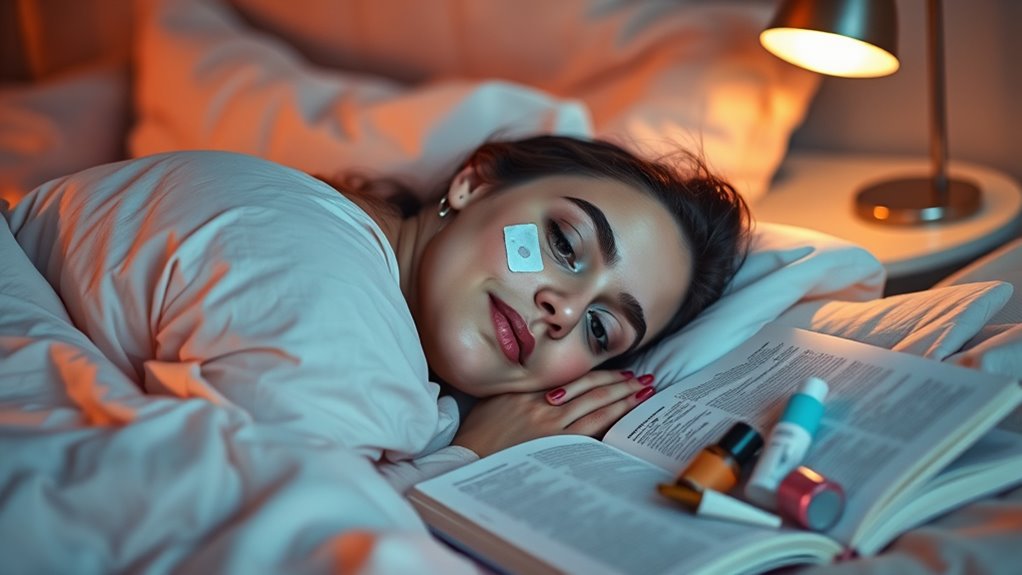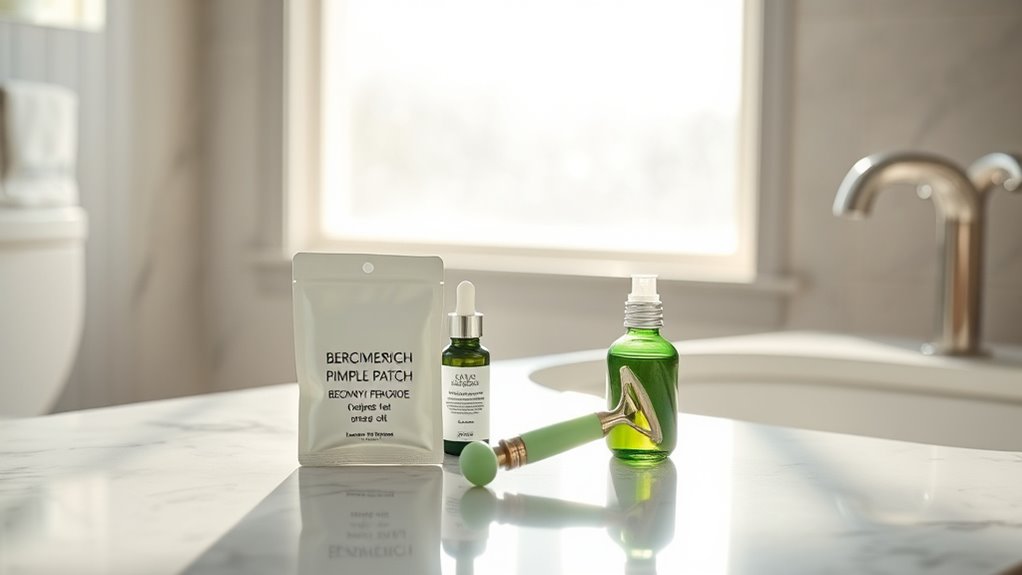For the best results with pimple patches, wear them for about 4 to 8 hours. If you want to maximize effectiveness, consider wearing them overnight for 8 to 12 hours. Larger, inflamed pimples might even allow for 24-hour use. Just keep an eye out for signs like the patch turning white or losing adhesion, which means it’s time to remove it. There’s even more to learn about different types of pimples and how to use patches effectively, so stick around!
Key Takeaways
- For optimal results, wear pimple patches for 4 to 8 hours; overnight use can extend this to 8 to 12 hours.
- Severe blemishes may allow for patch usage up to 24 hours, depending on skin type and acne severity.
- Signs it’s time to remove a patch include it turning opaque, losing adhesion, or causing skin irritation.
- Maximum effectiveness is reached when the patch turns white or cloudy, indicating saturation.
- Cleanse and moisturize the skin after patch removal to ensure continued skin health.
Recommended Duration for Pimple Patch Use

When it comes to using pimple patches, the recommended duration typically falls between 4 to 8 hours for best results. If you’re looking to maximize effectiveness, consider applying them overnight for 8 to 12 hours. For severe blemishes, some patches can be worn for up to 24 hours. However, to see noticeable results, aim for at least 6 hours of wear. Keep in mind that the type of acne and your skin type can influence how long you should wear a patch. Larger pimples may require longer usage, while oily skin might need shorter wear times due to adhesion issues. Always apply patches to clean, dry skin to guarantee they stick well and provide the best results. This will help the patch utilize its hydrocolloid technology to absorb excess oil and draw out impurities effectively.
Understanding Maximum Wear Time

Understanding the maximum wear time for pimple patches is essential for achieving the best results. These hydrocolloid patches absorb excess fluid and impurities, acting as a protective barrier while promoting faster healing. However, factors like skin sensitivity and the type of acne can influence how long you should keep a patch on. For instance, larger, inflamed pimples might benefit from extended wear, while oily skin may require shorter durations. You’ll know a patch is at its max effectiveness when it turns white or cloudy, indicating effective absorption of fluid. Once it loses adhesion or becomes saturated, it’s time to replace it. Additionally, different types of acne may respond better to varying patch durations, so pay attention to your skin’s needs. Always follow manufacturer guidelines to avoid irritation and guarantee ideal results.
Overnight Application Benefits

Applying pimple patches overnight can greatly enhance your skincare routine.
You’ll notice enhanced healing as the patch maintains a consistent environment for your skin to absorb its benefits. Prolonged wear reduces redness and inflammation, calming those pesky pimples while you sleep. Plus, the patch acts as a protective barrier against dirt and bacteria that could worsen acne. It’s a convenient addition; you put it on and let it work while you rest. Overnight wear also helps retain moisture, promoting faster healing and minimizing scarring. You might even wake up to clearer skin, with reduced blemish size and improved overall appearance. Consistency in overnight application leads to the best results, making it a smart choice for your acne treatment. Additionally, these patches are made from hydrocolloid material, which helps draw out pus and oil effectively.
Signs It’s Time to Remove the Patch

Knowing when to remove a pimple patch is essential for effective treatment. Look for visual indicators like the patch turning opaque or white; this means it’s absorbed its capacity for impurities.
If the patch starts peeling off, it’s time to take it off. Pay attention to any skin irritation; remove the patch if you feel discomfort. Also, make certain to follow the recommended wear time, typically 6 to 12 hours. When removing, do so gently from the edges to minimize irritation, and make sure your hands are clean to avoid bacteria transfer.
After removal, cleanse the area, moisturize, and monitor for any signs of irritation or infection to maintain healthy skin. Consistent use of pimple patches can lead to clearer skin over time, enhancing overall skin health.
Types of Pimples Suitable for Pimple Patches

Once you’ve determined the right time to remove your pimple patch, it’s important to recognize which types of pimples are best suited for treatment with these patches.
Pimple patches work wonders on surface-level acne like pustules and papules. If you’ve got whiteheads, hydrocolloid patches can absorb excess oil and pus effectively. Maintaining skin health through regular skin treatments can also aid in preventing future breakouts.
For open lesions, non-medicated patches are a great choice. Cystic acne may require microneedle patches for deeper treatment, but severe cases often need professional attention. Inflamed pimples benefit from medicated patches containing salicylic acid to reduce inflammation. Always choose the right type based on your specific blemish, as this guarantees ideal results and speeds up your healing process. Additionally, pimple patches are designed for one-time use and can be worn overnight to aid the healing process.
Application and Skin Preparation Tips

To achieve the best results with your pimple patches, it’s important to prepare your skin properly before application.
Start by using a gentle cleanser to remove dirt, oil, and makeup. After cleansing, pat your skin dry with a clean towel to guarantee the patch adheres well. It’s best to apply the patch before any other skincare products for ideal adhesion. Remember to wash your hands thoroughly to prevent spreading bacteria. For extra effectiveness, consider using a BHA toner to unclog pores. When selecting a patch, choose one that fully covers the pimple without being too large or small. Applying a patch can provide targeted treatment directly onto the clean, dry pimple, pressing gently to avoid air bubbles.
Benefits of Using Pimple Patches

Using pimple patches can considerably enhance your skincare routine, especially when dealing with stubborn blemishes.
These patches absorb excess fluid and promote a moist environment, aiding in healing while reducing inflammation. You’ll notice they effectively draw out pus and oil, often visible as a white spot on the patch. Additionally, hydrocolloid patches protect your skin and draw out excess fluid without sticking to the wound, ensuring a gentle healing process.
Plus, they protect your skin from external irritants and prevent damage from picking. The hydrocolloid material helps minimize redness and inflammation, making your skin look better faster.
Convenient and discreet, you can wear them throughout the day or overnight for continuous treatment.
With ingredients like salicylic acid, niacinamide, and tea tree oil, they not only target pimples but also improve your skin’s overall health.
Comparing Pimple Patches With Other Treatments

While pimple patches offer targeted relief for individual blemishes, they differ significantly from other acne treatments regarding application and effectiveness.
Unlike benzoyl peroxide, which directly kills bacteria, patches primarily use hydrocolloid to absorb oil and protect your skin. You can wear them discreetly during the day or overnight, making them convenient. Pimple patches are designed to create a protective barrier over pimples, promoting faster healing while preventing further irritation.
Topical creams may cover broader areas, but they lack the protective barrier that patches provide. Additionally, microneedling patches deliver ingredients deeper into the skin, targeting cystic acne more aggressively.
Combining patches with treatments like blue light therapy can enhance results. Ultimately, your choice depends on your specific needs, whether you prefer the gentle approach of patches or the potency of other treatments.
Frequently Asked Questions
Can I Use Pimple Patches on Sensitive Skin?
Yes, you can use pimple patches on sensitive skin!
These patches are typically made from hydrocolloid material, which gently absorbs impurities without harsh chemicals. They create a protective barrier, reducing irritation and the risk of scarring.
Just make sure to choose non-medicated options to avoid any potential irritation from active ingredients.
Always do a patch test first to check for any adverse reactions, and consult a dermatologist if you have concerns.
Are There Any Side Effects From Using Pimple Patches?
Did you know that about 30% of people experience skin irritation when using pimple patches?
While they can be effective, you might face side effects like redness, dryness, or even allergic reactions depending on your skin type and the patch ingredients.
If you have sensitive skin, the adhesives can cause further irritation.
It’s crucial to patch test and monitor your skin’s response to avoid complications.
Always consult a dermatologist for tailored advice.
How Many Patches Can I Use at Once?
You can use multiple pimple patches at once, depending on how many breakouts you have and how many patches you’ve got available.
There’s no strict limit, but make sure they don’t overlap. Apply each patch carefully to clean, dry skin for the best results.
If you’re treating different types of acne, consider using patches designed for specific issues, like salicylic acid patches for blackheads, to enhance effectiveness.
Can I Apply Makeup Over a Pimple Patch?
Imagine your breakout as a tiny monster, and the pimple patch as its fortress. Yes, you can definitely apply makeup over that fortress!
Just remember to be gentle, using a light touch to avoid dislodging it. Stick to thin layers of foundation and a matte concealer to blend seamlessly.
With the right products, you’ll camouflage that monster while letting the patch work its magic beneath.
Are Pimple Patches Reusable or Single-Use Only?
Pimple patches are generally single-use only. Once they absorb excess fluid and impurities, their effectiveness decreases considerably.
Reusing them can lead to skin irritation or infection, so it’s best to discard them after use. To maintain skin health, you should apply a fresh patch daily, especially if you’re using non-medicated hydrocolloid types.
Conclusion
Ultimately, finding the right wear time for your pimple patch is key to maximizing its benefits, just like knowing when to pull a cake from the oven guarantees it’s perfectly baked. Aim for overnight use or up to 12 hours for the best results, and be mindful of signs that it’s time to remove it. With proper application and care, pimple patches can be your secret weapon in the fight against blemishes, bringing you clear skin and confidence.








